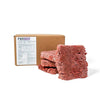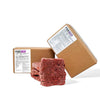The Science Behind Raw Feeding: What Dogs Are Designed to Eat
As pet parents, we want what’s best for our dogs—especially when it comes to their diet. Raw feeding has become a popular choice for many, but what’s the science behind it? Why do so many experts and pet owners believe that raw meat, bones, and organs are better for dogs than commercial kibble? In this blog, we’ll dive deep into the science of raw feeding and explain how dogs’ digestive systems are specifically designed to thrive on a raw, species-appropriate diet.
Dogs’ Digestive System built for raw food: Dogs are carnivores—but more specifically, they are facultative carnivores, meaning their bodies are adapted to thrive primarily on animal-based proteins and nutrients while still being able to digest some plant matter. Their digestive systems are designed to efficiently break down raw meat, bones, and organ tissues, mimicking the diets of their wild ancestors.
Here’s a closer look at why raw feeding is a natural fit:
Shorter Digestive Tract: Dogs have a much shorter digestive tract than humans or herbivores, which is ideal for processing meat and bones. This design allows them to absorb nutrients quickly and limits bacterial growth.
Source: National Research Council (2006). Nutrient Requirements of Dogs and Cats. The National Academies Press.
Strong Stomach Acid: Dogs’ stomachs produce hydrochloric acid with a pH as low as 1–2, which helps dissolve raw bones and destroy pathogens like Salmonella and E. coli.
Source: Zhang, W., et al. (2011). "Survival of Escherichia coli and Salmonella in the canine stomach." Journal of Veterinary Internal Medicine.
Teeth and Jaw Designed for Meat: Dogs’ dentition—pointed molars, large canines, and strong jaw muscles—are specifically evolved for tearing meat and crushing bone, not grinding plant material.
Source: Coppinger, R., & Coppinger, L. (2001). Dogs: A Startling New Understanding of Canine Origin, Behavior & Evolution.
Efficient Protein and Fat Metabolism: Dogs are metabolically adapted to use fat and protein as primary energy sources, unlike humans, who rely more on carbohydrates. Their livers and kidneys are excellent at processing raw animal products.
Source: Delaney, S. (2006). "Protein in Clinical Nutrition for Dogs and Cats." Veterinary Clinics of North America: Small Animal Practice.
Why Raw Mimics a Dog’s Natural Diet
Ancestral Variety: In the wild, canines consume a variety of prey animals—birds, rodents, fish—providing them with diverse nutrients. A well-structured raw diet with 3–4 proteins per month mimics this variety.
Bones for Minerals and Dental Health: Raw bones are nature’s toothbrush and a crucial source of calcium, phosphorus, and magnesium—nutrients often synthetically added to kibble.
Organ Meats Nature’s Multivitamins: Organs like liver and kidney are packed with vitamin A, iron, B12, and other vital nutrients. These are essential for hormone production, detoxification, and red blood cell health.
Source: Freeman, L. et al. (2013). "Current Knowledge About the Risks and Benefits of Raw Meat–Based Diets for Dogs and Cats." Journal of the American Veterinary Medical Association.
Raw Feeding vs. Kibble: A Comparative Look
Kibble is convenient, but often ultra-processed, heat-extruded, and made with grains, legumes, and artificial additives. This process destroys natural nutrients and alters protein structures.
In contrast, raw diets are minimally processed, nutritionally intact, and closer to a dog’s natural biological needs.
Source: Davies, M. (2014). "Diet and health in dogs and cats: Pointers to the future." Veterinary Record.
The Bottom Line: Dogs Are Built for Raw
From teeth to tail, your dog is biologically designed to eat what nature intended: fresh meat, raw bones, and nutrient-rich organs. Raw feeding supports digestion, dental health, skin & coat, and overall vitality.
Want to Learn More or Make the Switch?
Visit RawFedK9 today to browse our Prey Model Raw options.






